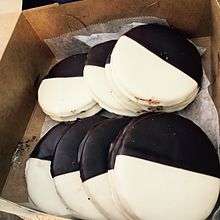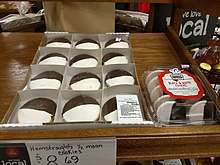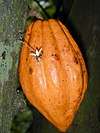Black and white cookie
 | |
| Alternative names | Half-and-half cookie |
|---|---|
| Type | Cookie |
| Course | Dessert |
A black-and-white cookie, half-and-half cookie, or half-moon cookie is a round cookie iced or frosted on one half with vanilla and on the other with chocolate. In the German language they are called Amerikaner. There are regional differences: strictly, a black-and-white cookie is flat, has fondant icing on a shortbread base, and is common in New York City, while a half-moon cookie is slightly dome-shaped, has frosting on a cake base, and is common in Central New York.[1] Often one side is frosted higher than the other. Black-and-white cookies may also be found with frosting instead of fondant.
The origin of the black-and-white cookie in New York City is commonly traced to Glaser's Bake Shop in Yorkville, founded in 1902 by Bavarian immigrants. The black-and-white cookie was among the original recipes used by the bakery.[2] Half-moon cookies, however, can be traced to Hemstrought's Bakery in Utica, New York, around 1925.[3] The relationship between the two origins is murky; it is likely that both recipes share a common German root, although the origin and name of Amerikaner in Germany is also unclear. Purported explanations include a corruption of the word Ammoniumhydrogencarbonat (ammonium bicarbonate, a leavening agent), or that the cookie was (re)introduced to Germany by American GIs in the 1950s.[4] German Amerikaner are often frosted entirely with vanilla.[5] In the former East Germany, due to anti-American sentiment, the name Ammonplätzchen (Ammonia cookies) was used.[6]
In popular culture

Black-and-white cookies are mentioned twice on Seinfeld, set in New York City. In the episode "The Dinner Party", Jerry eats a black-and-white cookie while waiting in a bakery with Elaine. He uses the cookie as a metaphor for racial harmony, saying if "chocolate and vanilla" can co-exist on a cookie they should be able to in life, suggesting people should "Look to the cookie!"[7]
Also in reference to for racial harmony, Barack Obama dubbed them Unity Cookies when visiting a deli in Hollywood, Florida in 2008.[8][9]
See also

References
- ↑ Sietsema, Robert. "New York in a Dozen Dishes". Houghton Mifflin Harcourt. pp. 279–290.
- ↑ Sietsema, Robert (Jun 2, 2014). "The Black-and-White Cookie's Curious History". Eater NY.
- ↑ D'imperio, Chuck. A Taste of Upstate New York: The People and the Stories Behind 40 Food Favorites. Syracuse University Press. pp. 69–72.
- ↑ Honnen, Peter (2008). Alles Kokolores? Wörter und Wortgeschichten aus dem Rheinland. Cologne: Greven Verlag. p. 10. ISBN 978-3-7743-0418-5.
- ↑ "WW2 Black and White Cookie". thrillist.com. Retrieved September 1, 2017.
- ↑ Martin, Ahrends (1986). Trabbi, Telespargel und Tränenpavillon. Das Wörterbuch der DDR-Sprache. Munich: Heyne. p. 18. ISBN 978-3-4530-2357-4. .
- ↑ Roberts, Sam (2016). A History of New York in 101 Objects. Simon and Schuster. p. 137.
- ↑ Clark, Lesley (21 October 2008). "Barack Obama and the black and white cookie". The Miami Herald. Retrieved 30 May 2013.
- ↑ Johnson, Sasha (21 October 2008). "Obama: McCain is 'running out of time' and 'making stuff up'". CNN. Retrieved 30 May 2013.
